
Brought to you by the Architects’ Journal. AJ sustainability editor Hattie Hartman and co-host Rachael Owens talk to changemakers and innovators who are transforming architecture by designing in ways that respect planetary boundaries. Nominated for Audio Content of the Year at the PPA Awards 2025. Show notes & more info here: https://www.architectsjournal.co.uk/podcasts
Episodes

Wednesday Feb 26, 2025
Material Cultures' Summer Islam: ‘We start with a map of nearby materials and products’
Wednesday Feb 26, 2025
Wednesday Feb 26, 2025
Episode 58. AJ Climate Champions with Hattie Hartman and Rachael Owens.
Material Cultures co-founder Summer Islam explains how a regional ‘materials matrix’ informs the design process.
‘We imagine the future, rather than working within the present,' says Islam, describing the approach of design and research consultancy Material Cultures. ‘We speculate on the potential for woodlands to produce certain materials, even though today we import them from mainland Europe.’
Material Cultures, co-founded in 2019 with Paloma Gormley and George Masoud, advocates greater use of biobased materials in construction and bioregional material sourcing. Bioregional mapping involves in-depth research to find out what resources, products and skills are local to a site, such as visits to sawmills and interviews with nearby foresters and farmers to build local supply chains.
Through built projects, hands-on workshops, research, teaching and films, Material Cultures has emerged as a significant disruptor of business as usual. The practice's main message is that our extractive construction industry needs a radical overhaul. ‘Our experience is that people want to make choices that align with their values’, Islam explains. ‘They just aren’t informed because we deliberately obscure, as an industry, the impact of certain processes and materials.’
Hands-on workshops with builders and community residents have evolved to be one of Material Cultures' most impactful workstreams, simultaneously addressing lack of industry understanding of how to build with biobased materials and empowering builders and local residents with new construction skills.
‘Straw is the ultimate equitable material. Everyone can pick up a bale and build with straw,’ says Islam. In addition to straw, Material Cultures advocates greater use of hemp and wood fibre. These are three regenerative materials which could be scaled in the British context, according to Islam.
In this episode, we also discuss Material Cultures' work with Civic Square in Birmingham, developing a neighbourhood microfactory for community retrofit. In terms of retrofit, Islam cautions that ‘more insulation is not always the answer.’ An awning or a minor modification to the plan might result in a more impactful outcome for a given cost.
For show notes and to catch up on all AJ Climate Champions episodes, click here.
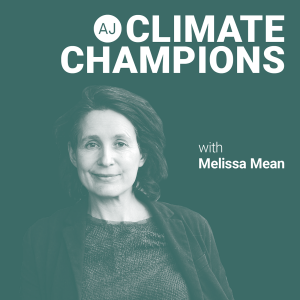
Wednesday Feb 12, 2025
‘Retrofit is seen as really alienating. We’re trying to blow that apart’
Wednesday Feb 12, 2025
Wednesday Feb 12, 2025
Episode 57. AJ Climate Champions with Hattie Hartman and Rachael Owens.
Melissa Mean from community land trust WeCanMake explains how a community-led approach in Bristol is tackling the housing crisis.
‘What if the power and resources to make good homes were in the hands of our communities? What if you literally put the tools in people's hands to design and make your own homes?’ asks Mean. For over a decade, WeCanMake has been doing exactly that, developing a bottom-up approach to ‘gentle densification’ in Bristol that builds social infrastructure and community wealth.
WeCanMake is pioneering a new approach to housing delivery on the Knowle West estate, an interwar housing estate of 5,000 homes in south Bristol. At its heart is an opt-in scheme whereby eligible social housing tenants gift a ‘microsite’ from their garden to someone with a housing need to build a home in their back garden. The components for the houses are cut to size by local residents in a neighbourhood micro-factory equipped with laser cutters and 3D printers and delivered to site for assembly.
The project started small with two prototype single-storey affordable homes now complete, two in planning and two more in the pipeline. Mean estimates that this approach could be rolled out in similar neighbourhoods across the UK to deliver more than 30,000 homes with just a 3% increase in density.
In this episode, Mean also describes current work with Mikhail Riches to explore the spatial transformation of Knowle West’s three-bed one-bath homes into four-bed two-bath houses.
Working with Waugh Thistleton, WeCanMake is now tackling larger sites such as small car arks and derelict garages and developing a kit of parts for low-rise buildings. Mean describes the multiple challenges of obtaining approvals for the use of bio-based materials.
‘We lean into the power and the joy of small. Knowle West and other neighbourhoods like it, can be the future of housing,’ says Mean.
For show notes and to catch up on all AJ Climate Champions episodes, click here.

Wednesday Jan 29, 2025
Tara Gbolade: ‘It’s unsustainable for small practices not to upskill’
Wednesday Jan 29, 2025
Wednesday Jan 29, 2025
Episode 56. AJ Climate Champions with Hattie Hartman and Rachael Owens.
Gbolade Design Studio’s Tara Gbolade shares insights from her new book, Changing the Game: How to be a sustainable and regenerative small practice.
Gbolade champions the nimbleness of small practices that enables them to rapidly pivot toward a more regenerative future. Drawing from her own experience and through a series of short case studies (nimtim, Knox Bhavan, Studio Gil, among others), she shares the simple steps designers can take to upskill without being ‘overwhelmed’.
Four-strong Gbolade Design Studio recently won an AJ architecture award for Hermitage Mews, eight net-zero town houses in Crystal Palace. In this episode, we also delve into the challenges and successes of that project. ‘What I’m most proud of is the friendships we built. We had a predominantly female-led team that has grown well past the project. We’re at each other’s hen dos and weddings,’ says Gbolade.
Collaboration is central to Gbolade Design Studio’s ethos. Shared values of sustainability, transparency and joyfulness determine the clients and projects the practice chooses to take on. Included in her book (co-authored with her business partner and husband Lanre Gbolade), is a ‘client assessment chart’ that sets out criteria for evaluating potential clients.
A founding member of the Paradigm Network that champions Black and Asian representation in the built environment, Gbolade touches on why the industry still has a long way to go. ‘We need procurement teams and client teams to be intentional, because none of this can happen without intentionality’.
In conjunction with this episode, RIBA Publishing is offering a 20% discount on Tara’s book. Use this code: CTG20 (valid until June 30).
For show notes and to catch up on all AJ Climate Champions episodes, click here.
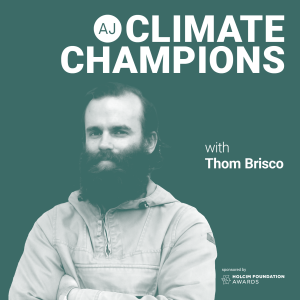
Wednesday Dec 11, 2024
‘Even a small practice can push the boundaries of reuse’ – Brisco Loran
Wednesday Dec 11, 2024
Wednesday Dec 11, 2024
Episode 55. AJ Climate Champions with Hattie Hartman and Rachael Owens.
AJ Climate Champions’ latest series focuses on retrofit. Our guest today is Thom Brisco of Brisco Loran, who talks to us about Costa's Barbers, a live-work shopfront which triumphed in the Project under £500,000 category at the AJ Architecture Awards last week.
Brisco describes the conversion of a former barbers in Battersea High Street for Arrant Industries into a home/office for himself and his partner Pandora Loran. Enabled by the recent expansion of ‘retail to residential’ permitted development rights, Costa’s Barbers sports a yellow shopfront, maroon signage and a deep awning which is rolled out on sunny afternoons or when ‘it’s spitting’, providing a popular place to linger and chat.
The architects have packed ingenuity into Costa Barbers’ 54 square metres. The shopfront incorporates sliding sash windows with panels of translucent patterned glass that can be adjusted for degrees of privacy. Behind is a tiled front room - which is used as an office and living space - and at the back the bedrooms are raised above ground level, due to flood risk from the nearby Thames.
The project incorporates numerous salvaged materials, including corbels which support the awning box that are made of quarter sawn snooker table legs. ‘We definitely feel like a different kind of architect now,’ says Brisco. ‘The process of going through a build like this has made us less precious about having all the decisions made up front and knowing where our materials are going to come from.’
The architects designed and self-built the project while living on site, which meant ‘two years without a shower, two years without heating and two years of all of our stuff covered in dust.’
Sponsored by Holcim Foundation Awards.
For show notes and to catch up on all AJ Climate Champions episodes, click here.

Wednesday Nov 27, 2024
IF_DO’s Sarah Castle: ‘People become the project’
Wednesday Nov 27, 2024
Wednesday Nov 27, 2024
Episode 54. AJ Climate Champions with Hattie Hartman and Rachael Owens.
AJ Climate Champions latest series focuses on retrofit. Our guest today is IF_DO founder Sarah Castle, who explains that community engagement is not just asking people what they want, but what they can do.
‘It’s about giving people the power to change their environments and making them feel part of it,’ Castle explains in this episode. It’s an approach that is at the heart of IF_DO’s work and is manifest in their work in Hastings, East Sussex, where they have transformed derelict buildings into affordable, community-centric spaces for social enterprise Hasting Commons.
We discuss the refurbishment of the grand 1924 Observer Building which had suffered more than three decades of neglect and a dozen owners when IF_DO took on the project. The first phase created a cultural venue with exhibition, theatre and music spaces, workspace, a cafe and gym. ‘It’s a space that can hold everything - from raves to weddings,’ says Castle.
IF_DO’s approach prioritises ‘essential improvements over cosmetic enhancements.’ Rather than allowing ourselves to get ‘overexcited about tile colours,’ we have to focus on making the building ‘robust, well-insulated and easy to look after,’ says Castle. The building’s intricately detailed faience facade has been upgraded through a careful balance of repair and renewal.
Central to IF_DO’s work is an understanding of procurement that is driven by available grant funding, which Castle terms ‘pod,’ phased organic development. Hastings Commons has secured over 100 grants over the last decade. The Observer Building is owned as a community land trust, which provides a legal framework to ensure affordability and perpetuity. ‘This creates protected spaces within a sphere of gentrification, where rents are controlled below market rates,’ Castle explains. ‘It’s about forever,’ she says.
Sponsored by Holcim Foundation Awards.
For show notes and to catch up on all AJ Climate Champions episodes, click here.
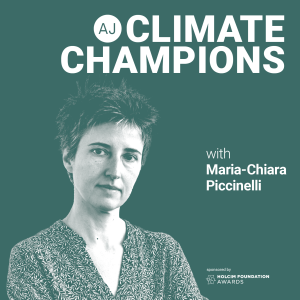
Wednesday Nov 13, 2024
Chipperfield’s MC Piccinelli on how retrofit can enhance creativity
Wednesday Nov 13, 2024
Wednesday Nov 13, 2024
Episode 53. AJ Climate Champions with Hattie Hartman and Rachael Owens.
AJ Climate Champions is back, with a new series focusing on retrofit. Our guest today is Maria-Chiara Piccinelli, associate director and project lead on the London School of Economics’ Firoz Lalji Global Hub (FLGH).
In the episode she explains how each building element requires one-to-one conversations to determine the best reuse, and that the contractor must be on the same journey. After deconstruction at FLGH, up to 70% of bricks were broken or crushed powder.
Piccinelli argues that a new design aesthetic, a hyperlocal vernacular, can emerge from the specificity of the building, its materials and its location. She cautions against the standard default response of using timber, insisting that all materials should be explored.
Sponsored by Holcim Foundation Awards.
For show notes and to catch up on all AJ Climate Champions episodes, click here.
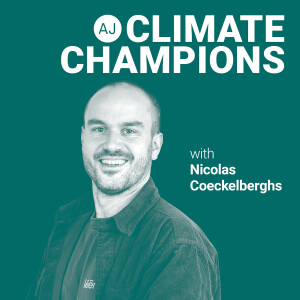
Thursday May 23, 2024
Why earth is the ultimate circular material
Thursday May 23, 2024
Thursday May 23, 2024
Episode 52. AJ Climate Champions with Hattie Hartman and Joe Jack Williams.
To achieve replication at scale, Nicolas Coeckelberghs of Brussels-based BC Materials favours compressed earth blocks over rammed earth.
‘Our goal is to bring earthen construction from a niche to a growing market,’ says Coeckelberghs. He likens this challenge to playing chess on multiple fronts, creating demand while simultaneously supplying the market. While acknowledging the aesthetic appeal of rammed earth, Coeckelberghs cautions that it is technically complex and unaffordable at scale.
In this episode, Coeckelberghs describes BC Architects’ 15-year trajectory from its first earth building in Burundi, to the proliferation of collaborative workshops which led to a strand of consultancy work, to the creation of cooperative BC Materials in 2018. This led in turn to the recent launch of Léém, a manufacturing company that produces circular materials: unfired bricks, and clay plasters and paints.
While Coeckelberghs is an innovator, he is also pragmatic and advocates focusing on easy wins. ‘Don’t use earth to make facades, just use it to make structures inside,’ he says. He sees enormous scope for application of earth blocks internally where they are protected from the weather and hence more durable.
In search of a way to scale the earth blocks production, BC Materials visited concrete and brick manufacturers across Belgium to understand their manufacturing techniques and explore possibilities for collaboration. Partnerships with large manufacturers are now underway, and BC Materials produces its blocks through ‘industrial co-working’, using the larger plants’ production line during their ‘off’ hours.
For show notes and to catch up on all AJ Climate Champions episodes, click here.

Wednesday May 08, 2024
Vinu Daniel on transforming mud and waste into architecture
Wednesday May 08, 2024
Wednesday May 08, 2024
Episode 51. AJ Climate Champions with Hattie Hartman and Joe Jack Williams.
Daniel views mud and waste as opportunities, not obstacles. He advocates an approach of ‘maximum optimism’, explaining that mud and waste enhance his designs. ‘I follow the materials; they do not follow me,’ he says.
Sourcing materials primarily from within five miles of a site, Daniel describes how mud and waste can be transformed into beautiful buildings. But this was not the case from the outset. Daniel first incorporated waste bottles into an early project because the budget ran out before the windows had been purchased. He then realised that a new aesthetic had emerged from this approach.
Daniel argues that architects need to be on site, not in the office, in order to observe their surroundings. ‘Open your eyes. Be out there!’ he advises. Architecture is not a white collar job; it’s about going to site, according to Daniel. ‘Today architects are not able to see because we are simply oblivious to what is happening around us. This way of practice has to change,’ he insists.
Daniel’s ambition is to bring earth construction to the mainstream and he is not opposed to adding small amounts of cement to his earth mixes to increase structural strength. ‘We need to enter commercial construction. If that means using a bit more steel or cement than the purest form of mud architecture, I’m open to it,’ he says.
For show notes and to catch up on all AJ Climate Champions episodes, click here.
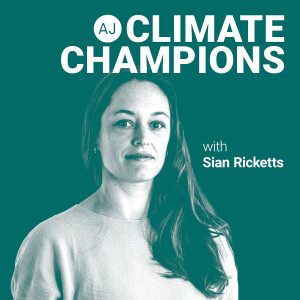
Wednesday Apr 24, 2024
Carmody Groarke’s Sian Ricketts on making bricks from waste
Wednesday Apr 24, 2024
Wednesday Apr 24, 2024
Episode 50. AJ Climate Champions with Hattie Hartman and Joe Jack Williams.
Carmody Groarke sustainability lead Sian Ricketts explains how architecture can adapt to the reality of finite resources and an abundance of waste.
Ricketts says that architects should develop their intuition and new rules of thumb to design for a changing climate. Architecture needs to adapt to incorporate materials from waste streams, and this requires a new approach to detailing and ongoing maintenance. ‘The industry is going through a huge learning process and we should not be scared of getting it wrong,’ she says. Marginal gains on every project are important.
In this episode, Ricketts describes the process of developing a bespoke brick for the Design Museum Gent in Belgium. She explains that the practice did not start with a bespoke brick in mind. Because conventional clay-fired bricks are high in embodied carbon, an exploration of less carbon intensive alternatives led to an in depth collaboration with Local Works Studio and Brussels-based bcmaterials that in turn led to incorporating local waste streams into the design of the new brick.
Ricketts observes that the process of developing the bespoke brick for Ghent has strengthened the practice’s confidence in seeking opportunities for both innovation and circularity in future projects. Carmody Groarke is currently working with Imperial College-based startup Seratech to explore the use of magnesium carbonate as a binder for bricks.
For show notes and to catch up on all AJ Climate Champions episodes, click here.
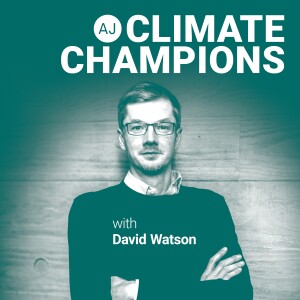
Wednesday Apr 10, 2024
AKTII’s David Watson on how to reduce the environmental impacts of brick
Wednesday Apr 10, 2024
Wednesday Apr 10, 2024
Ep 49. Structural engineer David Watson describes the enduring appeal of brick and its underexploited superpower: reuse
Brick has many advantages: durability, aesthetics, use as both envelope and structure, and the possibility of local (even artisanal) production. This last point differentiates it from steel and concrete, due to the Ordinary Portland Cement needed for concrete production. ‘We need to ‘build our intuition about what impacts embodied carbon and emissions from different materials,’ says Watson.
Watson highlights the importance of querying the firing required to achieve different finishes, because it varies between brick types and can significantly impact overall embodied carbon. It’s also important to understand the fuel used in the kilns where bricks are fired. While in the UK this is predominantly natural gas, abroad it might be charcoal or coal, both of which generate significant amounts of particulates.
In non-loadbearing cladding applications, the embodied carbon of the support systems must be taken into account because they can comprise as much embodied carbon as the brick and mortar combined. These hidden impacts are often difficult to calculate due to lack of EPD data, explains Watson.
Brick reuse is on the increase but currently comprises less than five per cent of the market because of the challenge of removing the mortar, particularly those bound with Ordinary Portland Cement. Traditional lime-bound mortars are easier to remove. Current research is exploring mechanised removal of cement-bound mortars, and increased demand should prompt the market to respond, says Watson.
In this episode, we also discuss ConcreteZero targets (AKTII is a signatory) and the extent to which they rely on GGBS. Watson stresses the necessity of ‘using less’, for example, exploring ribbed, coffered or troughed slabs as an alternative to flat slabs. He advocates form-effective design, marrying structure with architectural expression in a lean use of materials.
David Watson can be contacted at david.watson@akt-uk.com.
To catch up on all episodes of AJ Climate Champions, click here.
